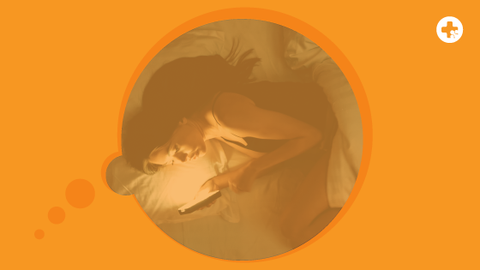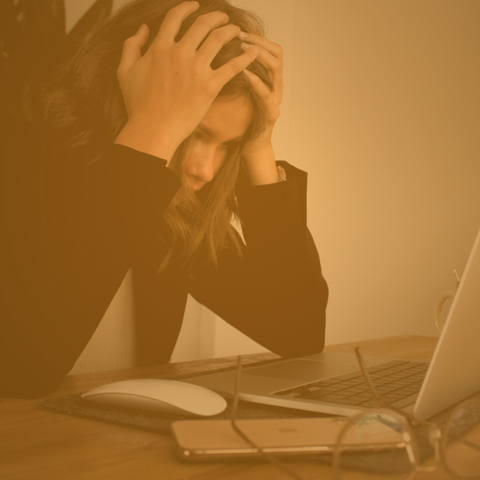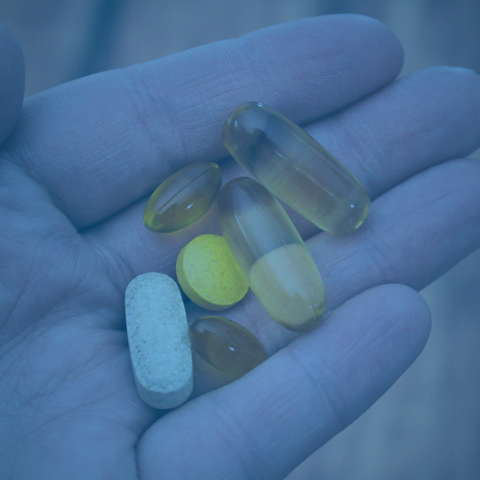
Mathew Walker famously said [1], “Sleep is the Swiss army knife of health. When sleep is deficient, there is sickness and disease. And when sleep is abundant, there is vitality and health.” Simple, right? Just get enough and you’re good.
Except that’s not so easy for many of us. Hello insomnia, our old friend (just like darkness… is this reference dating us?)...
The most common sleep disorder in the world is insomnia, defined as difficulty initiating or maintaining sleep with an associated daytime consequence [2]. In 2014, the third edition of the International Classification for Sleep Disorder (ICSD-3) classified insomnia into short-term, chronic, or other [3]. Short-term insomnia is if the symptom persists for less than three months, and chronic if the symptoms occur three or more times a week for three months or longer [3].
30-40% of US adults have reported insomnia [4], and annual losses in work performance due to insomnia in the US account for $97 billion [5].
In this article, we’ll discuss risk factors for insomnia, pharmaceutical interventions, and possible natural ways of addressing it. Typically we’d be offended if you fell asleep during one of our articles but this time, if it works for you, then amazing!
Risk Factors for Insomnia
Spielman’s 3P model best describes the risk factor of insomnia. The 3P model consists of “predisposing, precipitating, and perpetuating factors.”
Predisposing Factors for Insomnia
Predisposing factors increase the risk of insomnia and are dictated by demographics, hereditary, psychological, and social characteristics.
- Demographics
Insomnia is the most common sleep disorder in the older population. Studies have shown that more than 50% of the geriatric population complains of insomnia [6]. Researchers have found that females are significantly more prone to insomnia than males [7]. One of the studies found that women older than 45 have almost double the chance of developing insomnia than men [8].
- Genetics
In a study to find whether insomnia is inherited or not, researchers found a positive family history of insomnia in 72.7% of individuals with primary insomnia [9]. A meta-analysis also found that insomnia is inheritable [10].
- Psychological
A history of mental health disorders and chronic depression has a strong correlation with insomnia. Childhood trauma and post-traumatic stress disorder have also been associated with an increased risk as well [11].
- Social Characteristics
People with lower education or on the poverty line are also at increased risk of insomnia [8].
Precipitating Factors of Insomnia
Precipitating factors leading to insomnia include stress, work schedule, health, and environment. They can often be addressed through natural and pharmaceutical interventions.
- Stress
Stress is the primary factor behind insomnia and sleep-related disorders in our fast-moving world. Stress can arise from many factors related to personal or professional issues. A retrospective study found that 74% of respondents associated stressful life events as the main factor in their insomnia initiation [12]. The major stressful events in life are the death of a loved one, dissatisfaction at the workplace, marital problems, divorce, moving, or getting fired from a job (especially if you are old Marty McFly via fax… okay, another old reference!). Change in occupation or job transition also increases stress, which can increase risk for insomnia.
- Travel or Work Schedule
Our circadian rhythm controls the sleep-wake cycle, body metabolism, and acts as an internal clock. One of the most common examples of a job where circadian rhythms are disrupted is in airplane cabin crew and pilots. A recent study showed that 57.7% of the screened cabin crew complained of insomnia [13]. Researchers found that people working more than 55 hours had a significantly higher chance of insomnia than those working 35-40 hours a week [14].
- Health
Medical illness is reported to be a significant cause of insomnia as well. Among medical diseases, chronic pain is the top cause of insomnia. A study found that 22% of patients reported pain as the principal cause of the onset of their insomnia [15]. People with severe medical conditions have also reported increased sleep cycle disturbance and insomnia. It is still unclear whether health problems themselves or worries about health trigger the onset of insomnia but certainly many of the medications used for chronic illness can disturb sleep [15].
- Sleep Environment
The sleep environment is one of the most critical factors for a good night's sleep. Light exposure (or lack there of), the temperature of the room, and noise impact the quality of sleep. A study conducted in the intensive care unit found that reducing light and sound exposure improved patients' sleep quality [16].
Perpetuating Factors of Insomnia
These are behavioral or cognitive changes that come as a result of acute insomnia. Perpetuating factors include poor behavioral changes and unhelpful beliefs about sleep. Change in behavior or getting cognitive-based treatment can help to navigate perpetuating factors.
- Behavioral Changes
Poor sleep habits can cause short-term insomnia to evolve into a chronic issue [17]. These habits include daytime napping, irregular sleep-wake cycle, uncomfortable sleep environment, and performing brain-stimulating work before sleep. Additionally, eating before bedtime and using the computer or mobile phone can disturb the sleep cycle.
Another behavioral change that impacts the sleep cycle is the consumption of caffeine. Caffeine is an antagonist to adenosine, a neurotransmitter causing sleep [18]. Caffeine's average half-life in the body is around five to seven hours. If a person drinks a coffee at 6 PM, even at 11 PM, 50% of caffeine is still in the brain and may cause wakefulness. Renowned sleep scientist Mathew Walker says [1], “The consumption of caffeine represents one of the longest and largest unsupervised drug studies ever conducted on the human race, perhaps rivaled only by alcohol, and it continues to this day.”
- Unhelpful beliefs about sleep
Researchers have established that having unrealistic expectations about sleep is another interesting and common cause of chronic insomnia [19]. One of the common maladaptive beliefs in society is that a minimum of 8 hours of sleep is needed for proper body functioning. Scientists have shown that even 6-hour 30-minute quality sleep is suitable for a healthy person [20]. Many people who don’t get 8 hours of sleep feel anxious, and to compensate for perceived loss of sleep, they may spend an excessive amount of time in bed, leading to poor sleep habits. A study of 1300 participants showed that unhelpful beliefs are significantly associated with insomnia [21].
Interventions for Insomnia
Insomnia has many causes and requires a multifaceted approach to mitigate. Lifestyle, dietary, laboratory, and behavioral interventions are the most important for long-term benefit. However, in the short-term (and sometimes in the long-term as well), pharmaceutical and herbal remedies may also be considered.
- Prescription-based drugs
The most commonly prescribed medications for insomnia patients are benzodiazepine receptor agonists (BZRA) [22]. BZRA drugs are positive modulators of gamma-aminobutyric acid (GABA) and help reduce brain activity by increasing GABA, leading to decreased anxiety and help some people fall asleep. These drugs are rapidly absorbed into the body. Clinicians may prescribe patients with chronic insomnia BZRA drugs for the long-term [22]. Although they can help you fall asleep, they ruin sleep architecture, particularly slow-wave or deep sleep. They also have many potential side effects and stopping them abruptly may cause seizures or even death. Ouch.
- OTC drugs
22% of the elderly population in the US buy OTC drugs, according to a cross-sectional study, and a significant proportion of these OTC drugs are used for anxiety [23].
- Diphenhydramine
- Doxylamine
Anon-selective histamine receptor antagonist. A study conducted on 60 short-term insomnia patients found that usage of doxylamine in the short-term had significantly positive clinical effects [24].
A hormone produced by the pineal gland in the brain that controls the circadian rhythm. Intake of melatonin as a herbal supplement may improve sleep quality and improve insomnia. Melatonin has been well-researched over the years in randomized clinical trials. A meta-analysis of randomized controlled trials found that older patients with diagnosed insomnia showed beneficial effects on the onset and quality of sleep when administered melatonin compared to a placebo [25].
- Herbal Remedies
In addition to pharmaceutical measures and OTC drugs to improve sleep quality and help insomnia, traditionally, people have used many herbal remedies.
- Valerian Root
Has been used since the mid-century to reduce stress and improve sleep quality. Research has shown that the compound in valerian roots acts as a positive stimulator of GABA receptors and helps in slowing brain activity [26].
- Ashwagandha
- Lemon balm
(Melissa officinalis) is a native herb to West Asia, Europe, and North Africa. For centuries, lemon balm has been used to reduce stress and anxiety and improve sleep quality. In a large-scale study of 918 children, the researcher found that a combination of lemon balm and valerian root improved sleep quality in 81% of participants. The researcher also reported that 70% of participants had improvements in restlessness and anxiety [28].
Obtained from the pulverized roots of Piper methysticum, kava has been used for centuries in the South Pacific Islands as a beverage. Kava means “bitter” in the local language. In the South Pacific Islands, people know its medicinal effect and have used it to reduce stress, anxiety, and depression. Recent interest by the scientific community in the potential role of kava in treating insomnia and cancer has led to many studies to understand the mechanisms of kava in the body. A meta-analysis of a randomized controlled trial of kava was favored for general anxiety disorder over a placebo. Kava was found to be safe and well-tolerated in patients [29]. A recent review showed how kava is used in clinical trials for insomnia, stress, anxiety, and cancer [30].
- Cannabidiol (CBD)
Readily available and widely used to manage insomnia. Clinical studies have been conducted to check the efficacy of CBD in managing insomnia and other sleep-related disorders. A recent meta-analysis used 34 clinical studies on the management of insomnia using CBD as a mode of intervention. They observed that all studies improved the patients' insomnia symptoms [31]. A case report on a child suffering from post-traumatic stress and insomnia symptoms was published in 2016. When the patient was treated with pharmaceutical medication, she had partial relief and higher side effects. CBD oil resulted in an improvement in the quality of sleep and reduced anxiety [32]. These results suggest that CBD could be a potential game-changer in insomnia treatment. Large-scale trials are required to validate these claims.
Troscriptions: Tro Zzz
Tro Zzz works its magic by way of a novel combination of honokiol, adenosine, agarin, melatonin, CBD, CBN, cordycepin, and 5-HTP. It is our complete sleep solution troche that will help you fall asleep, stay asleep, and wake up feeling refreshed. Try it now!
References
[1]. Walker, M., 2017. “Why we sleep: The new science of sleep and dreams”. Penguin UK.
[2]. Wickwire, E.M., Shaya, F.T. and Scharf, S.M., 2016. Health economics of insomnia treatments: the return on investment for a good night's sleep. Sleep medicine reviews, 30, pp.72-82. DOI: https://doi.org/10.1016/j.smrv.2015.11.004
[3]. Zucconi, Marco. and Ferri, Raffaele, 2014. Assessment of sleep disorders and diagnostic procedures. Eur Sleep Res Soc,23(95), p.110., Link
[4]. Dopheide, J.A., 2020. Insomnia overview: epidemiology, pathophysiology, diagnosis and monitoring, and nonpharmacologic therapy. The American journal of managed care, 26(4 Suppl), pp. S76-S84. DOI: https://doi.org/10.37765/ajmc.2020.42769
[5]. Walker, J.L., Vargas, I., Drake, C.L., Ellis, J.G., Muench, A. and Perlis, M.L., 2022. The natural history of insomnia: high sleep reactivity interacts with greater life stress to predict the onset of acute insomnia. Sleep, 45(9), p. zsac149. DOI: https://doi.org/10.1093/sleep/zsac149
[6]. Patel, D., Steinberg, J. and Patel, P., 2018. Insomnia in the elderly: a review. Journal of Clinical Sleep Medicine,14(6), pp.1017-1024. DOI: https://doi.org/10.5664/jcsm.7172
[7]. Zeng, L.N., Zong, Q.Q., Yang, Y., Zhang, L., Xiang, Y.F., Ng, C.H., Chen, L.G. and Xiang, Y.T., 2020. Gender difference in the prevalence of insomnia: a meta-analysis of observational studies. Frontiers in Psychiatry,11, p.577429. DOI: 10.3389/fpsyt.2020.577429
[8]. Ohayon, M.M., 2002. Epidemiology of insomnia: what we know and what we still need to learn. Sleep medicine reviews,6(2), pp.97-111. https://doi.org/10.1053/smrv.2002.0186
[9]. Dauvilliers, Y., Morin, C., Cervena, K., Carlander, B., Touchon, J., Besset, A. and Billiard, M., 2005. Family studies in insomnia. Journal of psychosomatic research, 58(3), pp.271-278. DOI: https:/doi.org/10.1016/j.jpsychores.2004.08.012
[10]. Gehrman, P.R., Pfeiffenberger, C. and Byrne, E.M., 2013. The role of genes in the insomnia phenotype. Sleep medicine clinics, 8(3), pp.323-331. DOI: https://doi.org/10.1016/j.jsmc.2013.04.005
[11]. Germain, A., 2013. Sleep disturbances as the hallmark of PTSD: where are we now?. American Journal of Psychiatry, 170(4), pp.372-382. DOI: https://doi.org/10.1176/appi.ajp.2012.12040432
[12]. Healey, E.S., Kales, A., Monroe, L.J., Bixler, E.O., Chamberlin, K. and Soldatos, C.R., 1981. Onset of insomnia: role of life-stress events. Psychosomatic medicine. DOI: https://doi.org/10.1097/00006842-198110000-00007
[13]. Wen, C.C., Nicholas, C.L., Clarke-Errey, S., Howard, M.E., Trinder, J. and Jordan, A.S., 2021. Health risks and potential predictors of fatigue and sleepiness in airline cabin crew. International journal of environmental research and public health, 18(1), p.13. DOI: https://doi.org/10.3390/ijerph18010013
[14]. Virtanen, M., Ferrie, J.E., Gimeno, D., Vahtera, J., Elovainio, M., Singh-Manoux, A., Marmot, M.G. and Kivimäki, M., 2009. Long working hours and sleep disturbances: the Whitehall II prospective cohort study. Sleep, 32(6), pp.737-745. https://doi-org/10.1093/sleep/32.6.737
[15]. Bastien, C.H., Vallières, A. and Morin, C.M., 2004. Precipitating factors of insomnia. Behavioral sleep medicine, 2(1), pp.50-62. DOI: https://doi.org/10.1207/s15402010bsm0201_5
[16]. Bion, V., Lowe, A.S., Puthucheary, Z. and Montgomery, H., 2018. Reducing sound and light exposure to improve sleep on the adult intensive care unit: An inclusive narrative review. Journal of the Intensive Care Society, 19(2), pp.138-146. DOI: https://doi.org/10.1177/1751143717740803
[17]. Sidani, S., Ibrahim, S., Lok, J., O’Rourke, H., Collins, L. and Fox, M., 2021. Comparing the experience of and factors perpetuating chronic insomnia severity among young, middle-aged, and older adults. Clinical Nursing Research, 30(1), pp.12-22. DOI: https://doi.org/10.1177/1054773818806164
[18]. Ribeiro, J.A. and Sebastiao, A.M., 2010. Caffeine and adenosine. Journal of Alzheimer's Disease, 20(s1), pp. S3-S15. DOI: https://doi.org/10.3233/jad-2010-1379
[19]. Carney, C.E. and Edinger, J.D., 2006. Identifying critical beliefs about sleep in primary insomnia. Sleep, 29(3), pp.342-350. DOI: https://doi.org/10.1093/sleep/29.3.342
[20]. Pogue, D., 2018. Exclusive: What Fitbit's 6 billion nights of sleep data reveals about us. Yahoo Finance (cited 2019 Sep) Available from. URL: https://finance. yahoo. com/news/exclusive-fitbits-6-billion-nightssleep-data-reveals-us-110058417. html.
[21]. Carney, C.E., Edinger, J.D., Morin, C.M., Manber, R., Rybarczyk, B., Stepanski, E.J., Wright, H. and Lack, L., 2010. Examining maladaptive beliefs about sleep across insomnia patient groups. Journal of psychosomatic research, 68(1), pp.57-65. DOI: https://doi.org/10.1016/j.jpsychores.2009.08.007
[22]. Ng, B.J., Le Couteur, D.G. and Hilmer, S.N., 2018. Deprescribing benzodiazepines in older patients: impact of interventions targeting physicians, pharmacists, and patients. Drugs & Aging, 35(6), pp.493-521.DOI: https://doi.org/10.1007/s40266-018-0544-4
[23]. Maust, D.T., Solway, E., Clark, S.J., Kirch, M., Singer, D.C. and Malani, P., 2019. Prescription and nonprescription sleep product use among older adults in the United States. The American Journal of Geriatric Psychiatry, 27(1), pp.32-41. DOI: https://doi.org/10.1016/j.jagp.2018.09.004
[24]. Morin, C.M., Koetter, U., Bastien, C., Ware, J.C. and Wooten, V., 2005. Valerian-hops combination and diphenhydramine for treating insomnia: a randomized placebo-controlled clinical trial. Sleep, 28(11), pp.1465-1471. DOI: https://doi.org/10.1093/sleep/28.11.1465
[25]. Melnikov, A.Y., Lavrik, S.Y., Bikbulatova, L.F., Raginene, I.G., Ivanova, Y.A. and Zakharov, A.V., 2017. Effectiveness of reslip (doxylamine) in short-term insomnia: multicenter comparative randomized study. Zhurnal Nevrologii i Psikhiatrii Imeni SS Korsakova, 117(4. Vyp. 2), pp.56-59. DOI: https://doi.org/ 10.17116/jnevro20171174256-59
[26]. Culpepper, L. and Wingertzahn, M.A., 2015. Over-the-counter agents for the treatment of occasional disturbed sleep or transient insomnia: a systematic review of efficacy and safety. The primary care companion for CNS disorders, 17(6), p.26162. DOI: https://doi.org/10.4088/pcc.15r01798
[27]. Leach, M.J. and Page, A.T., 2015. Herbal medicine for insomnia: A systematic review and meta-analysis. Sleep medicine reviews, 24, pp.1-12. DOI: https://doi.org/10.1016/j.smrv.2014.12.003
[28]. Langade, D., Kanchi, S., Salve, J., Debnath, K. and Ambegaokar, D., 2019. Efficacy and safety of Ashwagandha (Withania somnifera) root extract in insomnia and anxiety: a double-blind, randomized, placebo-controlled study. Cureus, 11(9). DOI: https://doi.org/10.7759/cureus.5797
[29]. Müller, S.F. and Klement, S., 2006. A combination of valerian and lemon balm is effective in the treatment of restlessness and dyssomnia in children. Phytomedicine, 13(6), pp.383-387. DOI: https://doi.org/10.1016/j.phymed.2006.01.013
[30]. Ooi, S.L., Henderson, P. and Pak, S.C., 2018. Kava for generalized anxiety disorder: a review of current evidence. The Journal of Alternative and Complementary Medicine, 24(8), pp.770-780. DOI: https://doi.org/10.1089/acm.2018.0001
[31]. Soares, R.B., Dinis-Oliveira, R.J. and Oliveira, N.G., 2022. An updated review on the psychoactive, toxic and anticancer properties of kava. Journal of clinical medicine, 11(14), p.4039. DOI: https://doi.org/10.3390/jcm11144039
[32]. Ranum, R.M., Whipple, M.O., Croghan, I., Bauer, B., Toussaint, L.L. and Vincent, A., 2022. Use of Cannabidiol in the Management of Insomnia: A Systematic Review. Cannabis and Cannabinoid Research. DOI: https://doi.org/10.1089/can.2022.0122
[33]. Shannon, S. and Opila-Lehman, J., 2016. Effectiveness of cannabidiol oil for pediatric anxiety and insomnia as part of post-traumatic stress disorder: a case report. The Permanente Journal, 20(4). DOI: https://doi.org/10.7812/TPP/16-005





Comments (0)
There are no comments for this article. Be the first one to leave a message!